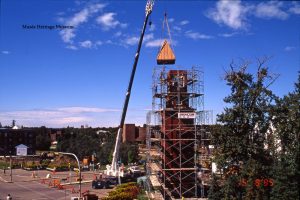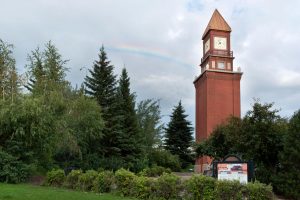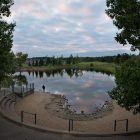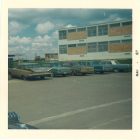Then & Now
PERRON STREET CLOCK TOWER
August, 2016
The clock tower on Perron Street is one of the more iconic buildings that make up the St. Albert skyline. And for many of us, it represents home. It ticks a friendly goodbye to us on our morning commute and stands there to welcome us home at the end of the day. Considering its familiarity, it might come as a surprise to hear that it isn’t actually a clock tower at all—at least, that’s not all it is. Since its construction in 1995, the Perron Street clock tower has also quietly been home to a University of Alberta research facility. Yes, really.
1990s
In the mid 90s, Mike Hatzinikolas, a professor of civil engineering at the University of Alberta, approached the then-mayor of St. Albert, Anita Ratchinsky, with a proposal. He wanted to study how bricks weather and erode over time, and to do that properly he needed a brick building to study. But not just any brick building. No existing buildings would do, as they had already started their centuries-long weathering process. Dr. Hatzinikolas needed a new building—one of his own. As you can guess, a deal was struck, and the U of A research station/St. Albert clock tower was born.

In June of 1995, construction began. To keep costs at a minimum, the construction crew was volunteer-based, and many of the materials were donated by various businesses within St. Albert. Over the next few months, the tower slowly rose, and in September, with no great fanfare, the building was completed. The tests could now begin.
From the outside, the tower appeared neat and uniform, but the inside of the tower told a different story. The four walls were constructed using four different methods, each simulating a different construction style. From those walls hung a myriad of weights, pendulums and machines used to conduct measurements on the structure. After less than a year, Dr. Hatzinikolas and his team acquired all of the measurements needed for their study, and the tower was left to fulfill its secondary purpose: to act as a giant timepiece for the people of St. Albert.
2000s
While the clock tower’s construction was a source of great excitement for the University of Alberta’s research team and for city council, the idea of watching the slow decay of bricks never really captured the imagination of the general public. Not surprisingly, the structure received little attention over the next decade, and by the mid 2000s, we were all more likely to be looking down at our phones for the time rather than up to the sky. The tower, however, quietly remained, slowly becoming a comforting sight on the horizon.
 2010s
2010s
The new decade brought renewed interest in the tower on the part of the University. New engineering professors reasoned that the tower could still yield valuable data and that there were exciting new experiments to be run. And so, in 2013, under the leadership of Dr. Yasser Korany, the University research teams returned to our clock tower.
Technology had changed quite a bit since the last time university researchers entered the tower, so the first order of business was to remove whatever weights and pendulums had been left behind and to replace them with the latest in electronic monitoring systems. Today, that data continues to be -collected. Exciting? Well, not by all definitions. It is, however, incredibly important work, as the structural degradation of buildings affects us all. If you’re concerned about our skyline once the tests are completed, don’t worry. Degradation is a remarkably slow process, and our clock tower will be with us for a long time to come. t8n
Fun Fact
The four gryphons that sit atop the tower were originally gargoyles donated by Hole’s Greenhouses & Gardens. They had to be replaced because they were a bit too small to see.
Did You Know?
Dr. Hatzinikolas originally wanted to build a leaning clock tower, as the added stresses of sloped walls would generate more interesting data. City council refused this request due to aesthetic concerns.













